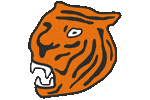News
|
More Hamilton Tigers History: Logos shown are for each time period.  1920/21:
After a disastrous 4-20 season the Quebec Bulldogs relocated to Hamilton, Ontario
and were renamed the Hamilton Tigers. Realizing more than a name change
would be needed to improve the club, the NHL ordered the other three NHL clubs
to supply players to the club, much like an expansion draft. The Montreal
Canadiens supplied Billy Coutu, while the Toronto St. Patricks supplied Joe Matte,
Goldie Prodgers, and future Hall-of-Famer Babe Dye. However, the Tigers would
no do much better finishing dead last with a 6-18-0 record. The Toronto St.
Patricks realizing they may have made a mistake in sending over Babe Dye for nothing
quickly demanded the return of Dye after just one game into the season;
the Tigers complied and accepted Mickey Roach from the St. Pats in his place.
Four games into the season the Tigers signed star forward Joe Malone, who
would go on to place amongst the NHL leaders with 28 goals. However the Tigers
would still play up to the level of the Bulldogs and went 3-7-0 in the first half,
and 3-11-0 in the second half, placing last place in both halves.
1920/21:
After a disastrous 4-20 season the Quebec Bulldogs relocated to Hamilton, Ontario
and were renamed the Hamilton Tigers. Realizing more than a name change
would be needed to improve the club, the NHL ordered the other three NHL clubs
to supply players to the club, much like an expansion draft. The Montreal
Canadiens supplied Billy Coutu, while the Toronto St. Patricks supplied Joe Matte,
Goldie Prodgers, and future Hall-of-Famer Babe Dye. However, the Tigers would
no do much better finishing dead last with a 6-18-0 record. The Toronto St.
Patricks realizing they may have made a mistake in sending over Babe Dye for nothing
quickly demanded the return of Dye after just one game into the season;
the Tigers complied and accepted Mickey Roach from the St. Pats in his place.
Four games into the season the Tigers signed star forward Joe Malone, who
would go on to place amongst the NHL leaders with 28 goals. However the Tigers
would still play up to the level of the Bulldogs and went 3-7-0 in the first half,
and 3-11-0 in the second half, placing last place in both halves. 1921/22: The NHL abandoned its split schedule format, but the Tigers still performed sub-par
posting a record of 7-17-0, gaining only 2 points over the previous season.
After the season, fed up with coaching the team, and wanting to concentrate
on building the team to elite status, head coach Percy Thompson quit and assumed
the role of general manager.
1921/22: The NHL abandoned its split schedule format, but the Tigers still performed sub-par
posting a record of 7-17-0, gaining only 2 points over the previous season.
After the season, fed up with coaching the team, and wanting to concentrate
on building the team to elite status, head coach Percy Thompson quit and assumed
the role of general manager.1922/23: Before the season the Tigers named Art Ross as their new head coach, but that was only minor compared to the moves Percy Thompson had in mind for the club. His first move surrounding the players of his team, Thompson signed former St Pats goalie Jake Forbes to replace "Holes" Lockhart in goal, and then signed future Hall-of-Famer Billy Burch away from the New Haven Westministers of the United States Amateur Hockey Association. The most controversial move of the season was the trading away of star forward Joe Malone to the Montreal Canadiens in exchange for Bert Corbeau and Edmond Bouchard. The controversy quickly quieted; as Malone would only go on to score 1 goal in 20 games with the Habs in 1922/23, while Bouchard led the league with 12 assists. Still in a re-building process the Tigers finished the season in last place for a 3rd straight season with a record of 6-18-0. Head Coach Art Ross was let go after the season in favor of Percy LeSueur.  1923/24: Under their new head coach the Tigers performed horribly for a 4th straight season
posting a record of 9-15-0. However the big news of the season was once
again the acquisition of players. The final pieces of the puzzle were obtained
in a span of ten days, as Thompson signed brothers Red and Shorty Green
from the Sudbury Wolves of the NOHA in November 1923. The brothers were signed
for a two-year contract worth $6000 in total, and were placed on a line with
Billy Burch. Thompson wasn't done; he bolstered the Tigers defense by
signing fellow Wolves stars Alex McKinnon and Charlie Langlois.
1923/24: Under their new head coach the Tigers performed horribly for a 4th straight season
posting a record of 9-15-0. However the big news of the season was once
again the acquisition of players. The final pieces of the puzzle were obtained
in a span of ten days, as Thompson signed brothers Red and Shorty Green
from the Sudbury Wolves of the NOHA in November 1923. The brothers were signed
for a two-year contract worth $6000 in total, and were placed on a line with
Billy Burch. Thompson wasn't done; he bolstered the Tigers defense by
signing fellow Wolves stars Alex McKinnon and Charlie Langlois. 1924/25: The addition of the four Wolves players made a world of difference for the Tigers, as NHL clubs only had 10 players per team in the 1920s. Under new head coach Jimmy Gardiner, the Tigers roared off to a 10-4-1 start by the mid-point of the season, and held off a late charge by the Toronto St. Pats to finish first in the NHL with a record of 19-10-1, earning them a birth in the NHL Finals. While the St. Pats and Canadiens began their semi-final series to determine the Tigers opponent in the NHL Finals, the 10 players of the Hamilton Tigers informed Percy Thompson that they would not take place in the NHL Finals unless they would receive an additional $200 each. Under their contracts the Tigers players were to receive the same amount of money no matter how many games they played from December 1, 1924 - March 31, 1925 (even though the season started on November 29, 1924). NHL President Frank Calder was not amused stating the players would be fined or suspended if they did not play in the final series, but the players stated they would rather retire than to be taken advantage of. The day of the final game of the Semi-Final Shorty Green met with Calder to try and reach an agreement, but to no avail. The players were all suspended and fined $200 each, therefore eliminating themselves from the playoffs. The NHL awarded its league title to the Montreal Canadiens who had defeated the St. Pats in the semi-final, the Habs went on to be defeated by the Victoria Cougars in the Stanley Cup Final, the only time an NHL team lost in the final series. Summer 1925: With the NHL expanding to the United States for the first time by placing a team in Boston, "Big Bill" Dwyer, New York's most-celebrated prohibition bootlegger purchased the Tigers from Percy Thompson for $75,000 and swiftly relocated them to New York's newly completed 18,000-seat Madison Square Garden, now known as the Americans, all of the Tigers players received raises, with many players salaries jumping almost 200%. |
